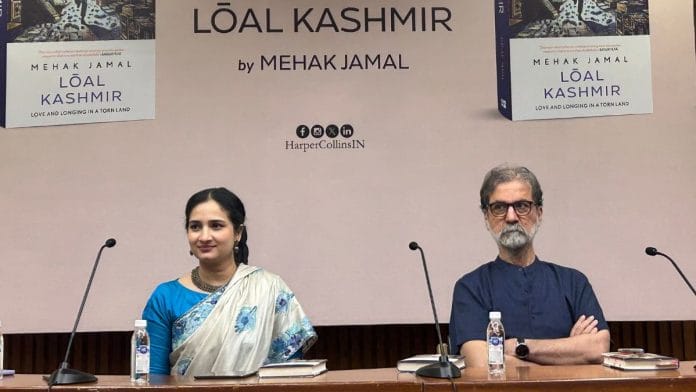New Delhi: In 2019, when a Kashmiri boy called his lover after they were separated for 40 days, he met with the news of her death. The abrogation of Article 370 and the following lockdown in the erstwhile state of Jammu and Kashmir crushed many love stories. This was just one of them. Now, a new book chronicles scattered stories of love, loss, and celebration in the valley.
Mehak Jamal, a filmmaker from Kashmir, felt compelled to document the love stories that had bloomed in silence—the pauses they endured and the quiet resilience of those who held on through the uncertainty. In Kashmir, where topics like love and relationships are not discussed openly among families, Jamal knew it was time to give the young voices a space to speak.
“I wanted to let them know that they were not alone in what they had gone through in the Kashmir unrest,” Jamal told ThePrint, soon after the release of her book Lōal Kashmir: Love and Longing in a Torn Land at Delhi’s India International Centre on 10 April.
The event was attended by around 60 people, including aspiring filmmakers, writers, students and several Kashmiris who came to hear about the book’s journey and get their copies signed by Jamal.
The author was joined by Sanjay Kak, a documentary filmmaker from Kashmir, for the book discussion.
Jamal made it clear that while other aspects of the Kashmir conflict have constantly been documented, love often got sidelined. Over the past four years—from the moment the idea first took root in Jamal’s mind to its eventual fruition as a book—one theme remained constant: love, or lōal, as it’s called in Kashmiri.
“Kashmir is always presented in a dichotomy but there are people who want to have somebody explore the middle ground of their day to day lives, their dreams, their desires, which is not spoken about enough,” said Jamal.
She said her interviewees often told her that people had never discussed this aspect of their lives. “Memory is fickle, so if you don’t document it, it is going to go away. A lot of these people wanted people who came after them to know that this had happened to them, to make it a reality,” the author said.
‘A secret potion’
Doraemon, one of the chapters in the book, is dedicated to the platonic love and friendship between two young girls, Mahak and Sehrish. Fresh out of school, they were not able to communicate with each other during the 2019 shutdown in J&K. In the book, Jamal writes that after days of waiting for the phone services to be restored, Mahak slowly started talking to herself, and when even that didn’t help, she started keeping a journal.
“When you kill someone, you silence their life. You erase their identity, you wipe them off the face of earth. But here in Kashmir, our feelings are getting killed. Poets and writers have done so much to capture feeling… And in the valley, nobody can feel. However, we are resilient and strong. Regardless of the crimes committed against us, we will continue to love. It’s our only secret potion, the remedy,” Mahak laments in the book.
For Sanjay Kak, this passage summarises Jamal’s book. The author explained that the character, Mahak, was left with one question—“who was going to make up for the lost time?”
To gather stories for Lōal Kashmir, Jamal chose WhatsApp, Instagram, email chains, and word of mouth. She used a simple Google form asking participants for their contact details, a brief on why they wanted to share their story, and whether they wished to remain anonymous, a choice most opted for.
Once responses began pouring in, the author personally reached out, speaking to people over phone calls, Zoom, and occasionally in person. Over the span of a few months, she had listened to at least 70 people from diverse age groups and backgrounds, creating an oral archive of deeply personal accounts.
Though the project began without any fixed format—initially imagined perhaps as a film—Jamal soon realised that only a book could do justice to the volume and nuance of the stories entrusted to her.
To shape the final manuscript, she sifted through the narratives carefully, aiming for both diversity and emotional range while avoiding repetition, especially as many stories were rooted in the same time frame around the abrogation of Article 370. Over time, the collection—with three parts, ōtrü (day before yesterday), rāth (yesterday), and az (today)—naturally divided itself, reflecting how younger generations were more willing to speak out, while voices from older generations remained fewer but no less significant.
Also read: Goldie Anand was the architect of cinematic rebellion. Guide centered a morally complex woman
A form of resistance
An interesting aspect that one comes across in Jamal’s book is how a big chunk of the stories have been narrated through the perspective of a woman. She told ThePrint that when it comes to love, women show a lot more agency than in other areas of their lives.
“They (women) wanted to talk about their love more than the men did,” she said.
As the discussion came to a close, many in the audience had questions for the author. Most of which revolved around how Jamal approached the characters in the book. The author innocently smiled and said, “I just got lucky.”
Jamal said that even though most of the stories in her book are romantic, her intention, however, was not to romanticise the conflict.
“It’s not the conflict that makes them love each other more. It is a form of resistance for them because they are loving beyond anything that is going around them,” she said.
“Love for them is an urgency.”
(Edited by Aamaan Alam Khan)






